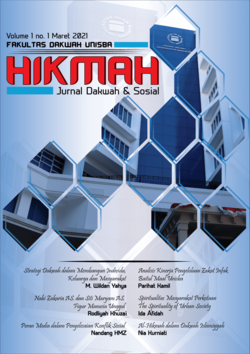PRAKTEK MEDIA DI MASA PANDEMI: TANTANGAN JURNALIS DAN PERUSAHAAN MEDIA
DOI:
https://doi.org/10.29313/hikmah.vi.2543Keywords:
Tantangan, Jurnalis, Perusahaan MediaAbstract
This article is derived from research that discusses media practices during the pandemic in terms of the challenges of journalists and media companies. Some data also show that there are different challenges for journalists when reporting non-natural disasters. Especially in the conditions of the COVID-19 outbreak, which until June 2020 had not found a vaccine to prevent the virus from spreading more widely. Therefore, this attracts the author's attention to examine media practices regarding the challenges of journalists during the COVID-19 outbreak and how the media owners care about journalists. The method used in this research is the study of documentation, interviews and texts sourced from relevant references and analysis of the object which is narrative. The results of this study have illustrated that the media for delivering information, media industry players and journalists remain committed to updating information and conveying it to the public even in very risky conditions such as during the COVID-19 outbreak. While the form of media company concern is establishing various policies that refer to government recommendations, such as work from home or working from home, implementing health protocols in the workplace, and facilitating personal protective equipment for workers who go directly to the field.
Artikel ini berasal dari penelitian yang membahas tentang praktek media pada masa pandemi dilihat dari segi tantangan para jurnalis dan perusaah media. Beberapa data pun memperlihatkan adanya tantangan yang berbeda-beda bagi para junalis saat terjadi peliputan bencana non-alam. Terutama pada kondisi wabah COVID-19 yang mana sampai bulan juni tahun 2020 belum ditemukannya vaksin untuk bisa mencegah virus tersebut untuk tidak tersebar lebih luas. Oleh karena itu, hal ini menarik perhatian penulis untuk mengkaji tentang praktek media mengenai tantangan jurnalis di masa wabah COVID-19 dan bagaimana kepedulian pemilik media terhadap jurnalis. Metode yang digunakan dalam riset ini ialah studi dokumentasi, wawancara dan teks yang bersumber dari rujukan yang relevan dan analisis pada objeknya yang bersifat naratif. Hasil penelitian ini telah menggambarkan bahwa media penyampaian informasi, para pelaku industri media berserta para jurnalis tetap berkomitmen untuk memperbaharui informasi dan menyampampaikannya ke masyarakat walaupun dengan kondisi yang sangat beresiko seperti pada masa wabah COVID-19. Sedangkan bentuk dari kepeduliaan perusahaan media yaitu menentapkan berbagai kebijakan yang merujuk pada anjuranpemerintah, seperti work from home atau bekerja dari rumah, menerapkan protokol kesehatan di tempat kerja, serta memfasilitas alat pelindung diri untuk para pekerja yang terjun langsung ke lapangan.
References
Arif, A. (2010). Jurnalisme Bencana, Bencana Jurnalisme. Kompas Group.
Benjamin, S., Lachal, J., & Radjack, R. (2020). Adolescent psychiatric disorders during the COVID-19 pandemic and lockdown. (January). https://doi.org/https://doi.org/10.1016/j.psychres
.2020.113264
Casero-Ripollés, A. (2020). Impact of covid-19 on the media system. Communicative and democratic consequences of news consumption during the outbreak. Profesional de la Informacion, 29(2), 1–11. https://doi.org/10.3145/epi.2020.mar.23
Cottle, S. (2012). Journalist witnessing disaster. Journalism Studies, 14(2), 232–248. Diambil dari https://www.tandfonline.com/doi/abs/10.1080/1 461670X.2012.718556?journalCode=rjos20
Deuze, M. (2002). National News Cultures. Journalism and Mass Communication Quarterly, 79(1), 134–
149. Diambil dari https://journals.sagepub.com/doi/abs/10.1177/10 7769900207900110
Ecip, S. S. (2007). Jurnalisme Mutakhir, Panduan dari atas Meja. Jakarta: Rebuplika.
Junsheng, H., Akhtar, R., Masud, M. M., Rana, M. S., & Banna, H. (2019). The role of mass media in communicating climate science : An empirical evidence. Journal of Cleaner Production, 238, 117934.
https://doi.org/10.1016/j.jclepro.2019.117934
Kovach & Rosenstiel, B. & T. (2012). Sembilan Elemen Jurnalisme. Jakarta: pantau.
Masduki. (2007). ”Wajah ganda media massa dalam advokasi bencana alam”. Jurnal Unisia, 63.)30(
Mubarak, H. A. (2020). Pemerintah Golongkan Wabah Corona sebagai Bencana Nonalam. Diambil dari cvnindonesia.com website: https://www.cnnindonesia.com/nasional/202003
11184040-20-482603/pemerintah-golongkan- wabah-corona-sebagai-bencana-nonalam
Reynold B & seeger, M. W. (2005). Crisis and Emergency Communication as an Integrative Model. Journal of health, 10, 43–45.
Richard & Rees, B. & G. (2011). The Management of Emotion in British Journalism. media, culuter and Society, 33(6), 851–867.
Schudzon, M. (2008). Why Democracies Need Unloveveable Press. cambridge.
Sukmono, F. G., & Junaedi, F. (2018). Jurnalisme Sensitif Bencana Dalam Manajemen Pencarian, Pengelolaan Informasi Dan Pemberitaan Bencana Di Ruang Redaksi. Jurnal ASPIKOM, 3(4), 712.
https://doi.org/10.24329/aspikom.v3i4.185
Tandoc & Takahashi, E. C. & J. B. (2018). Journalists are humans, too: A phenomenology of covering the strongest storm on earth. Journalism, 19(7), 917– 933.
Tiggemann, M., & Anderberg, I. (2019). Social media is not real: The effect of ‘Instagram vs reality’ images on women’s social comparison and body image. New Media and Society. https://doi.org/10.1177/1461444819888720
Wilkins, L. (2005). Plagues Pestilence and Pathogens: The Ethical Implications of News Reporting of a Health Crisis. Asian journal Of Communications, 15(3), 247–254. Diambil dari 10.1080/01292980500260698













